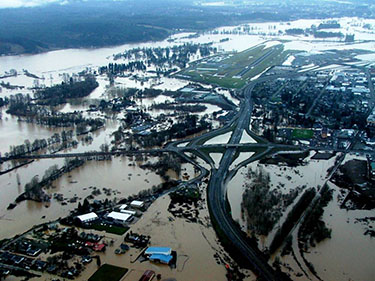|
Subscribe / Renew |
|
|
Contact Us |
|
| ► Subscribe to our Free Weekly Newsletter | |
| home | Welcome, sign in or click here to subscribe. | login |
Construction
| |
 |
March 29, 2018
Let’s make buildings people can still use after a disaster
Collinswoerman

Moddemeyer
|
We are trained and required to design and build buildings and infrastructure to a life safety or public health standard.
That means that anyone in a code-compliant building will survive the next big earthquake, windstorm or flooding event. However, that also means that our buildings or infrastructure may or may not be usable after the event.
When buildings and infrastructure are designed to be expendable that means they have to be repaired before we can use them. We’ll have major disruption for months or longer as we struggle to get back to work, back to school, and back home in safe housing.
It made sense in the past to select a threshold for design because if we tried to resist the truly huge and rare events we’d stand a good chance of overbuilding, overstrengthening, and overspending for an event that may not even happen during the usable life of the building.
But the realities of climate change and earthquake risk are pushing back on our presumptions. With climate change we are learning we can no longer predict the probability of an extreme event because background conditions in the climate are already shifting around us.
For example, many of the major rivers around Puget Sound are already being reshaped as huge sediment loads are mobilized as snow fields retreat and rain events gain in ferocity. This adds additional and potentially significant uncertainty in predicting the likelihood of a flood. Storm surge on top of rising seas means more floods in shoreline areas.
Recovery time
Structural engineers and planners in the earthquake community are recognizing that the metric for earthquakes should be more than just the size of the event. They are beginning to also include the length of time it takes to recover once an extreme event does take place.
This focus on recovery time is already included in the state resilience plans for Washington and Oregon, and in the Community Resilience Planning Guide by the National Institute for Standards and Technology.
Expectations for design professionals will be shifting as we are asked to add recovery time as a design metric. Everyone will still want cost-effective design and construction that is reliable, but we can expect that more and more often we will be asked to include quick recovery with that reliability.
This does not mean that everything just needs to get hardened or made bulletproof. In fact, maybe the opposite is in order. Sometimes the best design solutions to help users to recover more quickly are flexible and adaptable rather than bulletproof. If we can design a facility that recovers quickly with spare parts in storage, then we may be able to save on other costs.
Some clients may be happy to trade frequency of failure for speed of recovery. For example, if a bridge is washed out, wouldn’t it be better if it could be repaired in just weeks with replaceable parts rather than the years it now takes to rebuild a bridge and access roads far above a stream bed that mostly just runs low?
There is an equity challenge woven in as well. The people who have the most difficulty with a long recovery are those with limited credit, limited savings and limited social networks. Small businesses suffer especially.
According to the Federal Emergency Management Agency, 40 percent of small businesses fail after a significant event disrupts the economy. That’s because revenues plunge immediately while the rent and the debt never sleeps.
Habitability
Even with required performance standards for resisting catastrophic events, we can develop solutions like modular replacement parts that can be held in off-site storage.
Or we can shift the design to minimize the vulnerability of interior finishes to damage or exposure to the elements with the goal of making buildings suitable for occupancy during repairs.
In the Bay Area there is an ongoing policy discussion about this very thing, which they have termed “habitability.” From experience they know that if buildings are not suitable for immediate occupancy during repairs, whole communities are pushed to outlying areas, making recovery that much harder. The Association of Bay Area Governments estimates a habitability standard would raise costs less than 2 percent.
Resilience thinking is also ongoing in our own state. The Puget Sound Regional Council, which includes four counties, more than 80 cities and some area tribes, recently held a workshop looking at how to integrate resilience thinking into what they do.
The terms “resilient” and “sustainable” mean so much more than being resistant to damage or using fewer resources to operate. If we accept that climate change is shifting the baseline for extreme events already, and if we do care who is impacted, the next step is to shift our focus to a solution that reduces the impact to our communities and resources in a manner that accelerates recovery — for all of us.
Steve Moddemeyer, a principal at CollinsWoerman in Seattle, has more than 22 years of experience leading governments, land owners, and project teams towards increased sustainability and resilient infrastructure.
Other Stories:
- New green rating systems go way beyond LEED
- How cleaner indoor air makes for healthy workers and a healthier bottom line
- Cheap solar energy won't end the need for deep-green buildings
- To meet green goals, cities must grow more strategically
- Asphalt: the go-to material for green paving projects
- Climate change is making resilience a more urgent design priority
- We designed our own net-zero office — and you can, too
- SPU remodel shows even industrial buildings can be green
- Why we can’t reach our emissions goals without tracking embodied carbon



